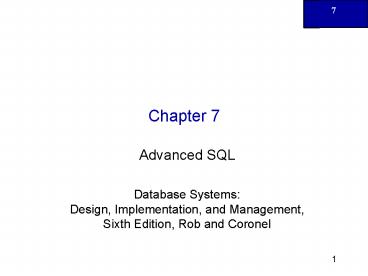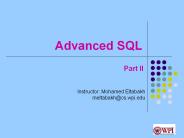Advanced SQL - PowerPoint PPT Presentation
1 / 62
Title:
Advanced SQL
Description:
Design, Implementation, and Management, Sixth Edition, Rob and Coronel ... About the relational set operators UNION, UNION ALL, INTERSECT, and MINUS ... – PowerPoint PPT presentation
Number of Views:637
Avg rating:3.0/5.0
Title: Advanced SQL
1
Chapter 7
- Advanced SQL
- Database Systems Design, Implementation, and
Management, Sixth Edition, Rob and Coronel
2
In this chapter, you will learn
- About the relational set operators UNION, UNION
ALL, INTERSECT, and MINUS - How to use the advanced SQL JOIN operator syntax
- About the different types of subqueries and
correlated queries - How to use SQL functions to manipulate dates,
strings, and other data
3
In this chapter, you will learn (continued)
- How to create and use updatable views
- How to create and use triggers and stored
procedures - How to create embedded SQL
4
UNION Query Result
5
UNION ALL Query Result
6
INTERSECT Query Result
7
MINUS Query Results
8
INTERSECT Alternative
9
MINUS Alternative
10
SQL Join Expression Styles
11
NATURAL JOIN Result
12
JOIN USING Result
13
JOIN ON Result
14
Outer Joins
- Returns not only rows matching join condition but
also rows with unmatched values - Three types
- Left
- Right
- Full
15
LEFT JOIN Result
16
RIGHT JOIN Result
17
FULL JOIN Result
18
SELECT Subquery Examples
19
WHERE Subquery Examples
20
IN Subquery Example
21
HAVING Subquery Example
22
Multirow Subquery Operator Example
23
FROM Subquery Example
24
Inline Subquery Example
25
Correlated Subquery Examples
26
EXISTS Correlated Subquery Examples
27
Selected MS Access/SQL Server Date/Time Functions
28
Selected Oracle Date/Time Functions
29
Selected Oracle Date/Time Functions (continued)
30
Selected Oracle Numeric Functions
31
Selected Oracle String Functions
32
Selected Oracle Conversion Functions
33
Selected Oracle Conversion Functions (continued)
34
Oracle Sequence
35
Oracle Sequence Examples
36
The PRODMASTER and PRODSALES Tables
37
The Oracle UPDATE Error Message
38
Creating an Updatable View in Oracle
39
PRODMASTER Table Update, Using an Updatable View
40
Anonymous PL/SQL Block Examples
41
SHOW ERRORS
- Can help diagnose errors found in PL/SQL blocks
- Yields additional debugging information whenever
an error is generated after an PL/SQL block is
created or executed
42
Anonymous PL/SQL Block with Variables and Loops
43
PL/SQL Basic Data Types
44
The PRODUCT Table
45
Creating the TRG_PRODUCT_REORDER Trigger
46
Verifying the TRG_PRODUCT_REORDER Trigger
Execution
47
The P_REORDER Value Mismatch After Update of the
P_MIN Attribute
48
Stored Procedures Advantages
- Substantially reduce network traffic and increase
performance - No transmission of individual SQL statements over
network - Help reduce code duplication by means of code
isolation and code sharing - Minimize chance of errors and cost of application
development and maintenance
49
Creating the PRC_PROD_DISCOUNT Stored Procedure
50
Results of the PRC_PROD_DISCOUNT Stored Procedure
51
The PRC_CUS_ADD Stored Procedure
52
The PRC_INV_ADD and PRC_LINE_ADD Stored Procedures
53
Testing the PRC_INV_ADD and PRC_LINE_ADD
Procedures
54
Cursor Processing Commands
55
Cursor Attributes
56
SQL and Procedural Languages Key Differences
- Run-time mismatch
- SQL executed one instruction at a time
- Host language typically runs at the client side
in its own memory space - Processing mismatch
- Host language processes one data element at a
time - Data type mismatch
- Data types may not match
57
Embedded SQL Framework
- A standard syntax to identify embedded SQL code
within host language - A standard syntax to identify host variables
- A communication area used to exchange status and
error information between SQL and the host
language
58
SQL Status and Error Reporting Variables
59
Static SQL
- Embedded SQL in which the programmer used
predefined SQL statements and parameters - End users of programs are limited to actions that
were specified in application programs - SQL statements will not change while application
is running
60
Dynamic SQL
- SQL statement is not known in advance, but
instead is generated at run time - Program can generate SQL statements at run time
that are required to respond to ad hoc queries - Attribute list and the condition are not known
until the end user specifies them - Tends to be much slower than static SQL
- Requires more computer resources
61
Summary
- SQL provides relational set operators to combine
output of two queries to generate new relation - Operations that join tables can be classified as
inner joins and outer joins - Subqueries and correlated queries are used when
it is necessary to process data based on other
processed data - SQL functions are used to extract or transform
data
62
Summary (continued)
- Oracle sequences may be used to generate values
to be assigned to a record - PL/SQL may be used to create triggers, stored
procedures, and PL/SQL functions - If SQL statements are designed to return more
than one value inside the PL/SQL code, a cursor
is needed - Embedded SQL refers to the use of SQL statements
within an application programming language































